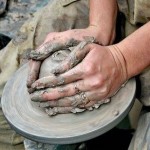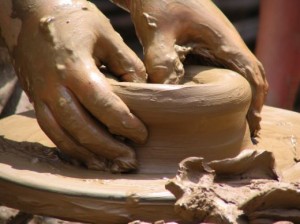I love watching a skilled potter. As the wheel turns, it almost looks like the potter’s hands bring the clay to life, forming the outside and inside of the vase from the bottom up. It looks easy enough. I know it’s not.
A student told our university class about making pottery on a wheel. She said there were two main things you have to do before you can make anything on a wheel. The first thing you have to do is “work the clay.” That means rolling it and pushing it and folding in over and over so that the clay is more pliable and workable. Clay gets hard and brittle if not worked. This also gets any bubbles out of the clay. If there are bubbles in the clay, it won’t hold together when you fire it in the kiln. Working it is the way of taking all the things out of the clay that aren’t needed in the final product and making it easier to work with.
 “Once you have worked the clay”, she said, “you have to center it on the wheel.” That means exactly what it says, getting the clay right in the center so that when the wheel is turning, the clay stays in the middle. If the clay is not centered, it will wobble back and forth as the wheel turns, making it impossible for the potter to work with it properly.
“Once you have worked the clay”, she said, “you have to center it on the wheel.” That means exactly what it says, getting the clay right in the center so that when the wheel is turning, the clay stays in the middle. If the clay is not centered, it will wobble back and forth as the wheel turns, making it impossible for the potter to work with it properly.
Once the clay has been worked and is centered, the potter can start the wheel and begin, either fashioning something already in mind or letting the clay and the hands work together to form something beautiful but not yet imagined.
Here is life in a lump of clay. How many days of my life have been lived without my first doing these two simple but crucial tasks? How many days have I lived with my mind and my body rigid and unpliable, my schedule and attention full of extra stuff that causes me to feel brittle and fractured? How many days have I lived my life wobbling off-center, just hanging on until the end of the day when I fall asleep hoping the next day is different?
Wise people from every generation and every religion talk about these two basic tasks to healthy, focused living. Rid yourself of the extras, and get centered before you take action.
Every serious athlete knows these two things. Every serious devotee of a spiritual practice knows these two things. Every person who is committed to developing a new skill or to getting emotionally or physically healthy in any way knows these two things.
Get the bubbles out, get centered. It’s pretty simple, and it’s nearly impossible. Most of us (I include myself), from the moment we wake up fill our days with busyness, with things that keep us from being centered. In fact, I usually convince myself that taking the time to get the bubbles out, making my mind more pliable, and getting centered would put me behind schedule. I fear that I’ll spend the rest of the day playing catch-up from the time I spent doing these important tasks.
It seems like a needless expenditure of time—until I take the time to do it. Things begin to change only when I take the time to get the bubbles out and get centered. For me this involves taking 5-10 minutes in the morning to sit still, breathe deeply, and simply pay attention to my thoughts.
 Interestingly, taking the time for something so simple, yet so vital, doesn’t make sense even while I’m sitting there and breathing. It only makes sense when I continue to sit through my first few moments of discomfort and impatience. Only then do I feel some of the bubbles getting squeezed out. Only then does my mind feel more pliable. Only then do I feel myself moving toward the center of the wheel. Only then do I feel something both solid and light happening. My mind slows, my breathing slows, and the blur of mental activities settles like blowing leaves falling once the wind stops.
Interestingly, taking the time for something so simple, yet so vital, doesn’t make sense even while I’m sitting there and breathing. It only makes sense when I continue to sit through my first few moments of discomfort and impatience. Only then do I feel some of the bubbles getting squeezed out. Only then does my mind feel more pliable. Only then do I feel myself moving toward the center of the wheel. Only then do I feel something both solid and light happening. My mind slows, my breathing slows, and the blur of mental activities settles like blowing leaves falling once the wind stops.
The more days each week I do this, the more easily the settling happens. When I stop for a few days, the brittleness returns, the flurry begins again.
It helps me to get centered right at the beginning of the day. It helps set the tone for the day. I can do it any time during the day when I get off-center, but it’s more difficult to pay attention once the flurry of the day’s activities pick up speed.
The student who introduced me to this lesson in clay ended her presentation with a surprise. She said, “The more you work with clay, the more you practice centering it, eventually, when you put the clay on the wheel, it’s almost as if the clay centers itself.”
3 Comments until now
What a wonderful post! My experience has been similar, but you have captured it in such a nice way. I’ve had to share this post with others….
Thanks, Aaron. I love the imagery and the meaning of those simple tasks.
Love this post, John. It is interesting to reflect that probably most of our actions are reactive, and done without being centered…You bring up such an insightful discussion of the value of getting centered first…
Add your Comment!